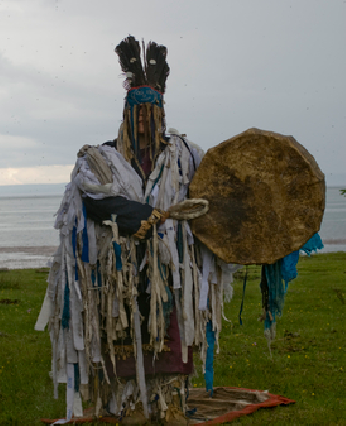 It seems that most of us commonly think that cultures other than our own are somehow backward or primitive. However, social scientists recently have been coming to the conclusion that alternative cultures constitute a rich store of useful cultural resources in the form of ideas and behaviors that may help us solve real world problems.
It seems that most of us commonly think that cultures other than our own are somehow backward or primitive. However, social scientists recently have been coming to the conclusion that alternative cultures constitute a rich store of useful cultural resources in the form of ideas and behaviors that may help us solve real world problems.
The National Geographic’s explorer in residence, Wade Davis, points out that much in the same way that new medicines are being discovered in the exploration of the Amazon, new answers to how to create a balanced and meaningful life have been preserved in the intact indigenous cultures of the world. It is a shame that we are so quickly losing both, even before we have the chance to catalog and learn to utilize these beneficial resources.
My teacher of 17 years, Tom Best, came from a cultural anthropology background and used his interest in traditional cultures, along with his extremely proficient skills at modeling cognitive-behavioral patterns, to detail and share many fascinating and useful cultural-based patterns of thinking, feeling and behaving.
His immersion into and study of indigenous cultures that are still in touch with their coherent roots convinced him that we in the modern Western culture are missing important opportunities to improve our world because, like water to the fish, we are completely ensconced in our own cultural norms. These Western norms include prolific efforts to export so called, “Western economic success” worldwide. This cultural hegemony is so superabundant that we are scarcely aware or concerned that so many fascinating and valuable cultures are now on the edge of extinction.
From Tom, I began to truly appreciate that cultural patterns are much like their cognitive cousins. They tend to provide really rich value when you recognize them as “meta-patterns.” By this I mean patterns that are common across a variety of contexts. Each culture’s meta-patterns underlie particular skills and behaviors unique to that culture. But when they are coherently abstracted from their original context, we can incorporate them as new skills and behaviors within our own culture to produce useful new results. Of course this sort of modeling is more art than science and requires that we make the transfer with great respect and sensitivity to the differences between the host culture and the incorporating one. Otherwise the pattern may not even make sense, much less be useful in the new context.
Cultural Modeling, Not Cultural Appropriation
It is also important that we recognize that cultural appropriation can, and often has been performed in a disrespectful way. Many times for example, Westerners have been called “plastic shamans” when they plagiarized patterns like the sweat lodge and peacepipe ceremonies from Native Americans without full respect and understanding for the rich complexity of the original cultural context. This egoic “playing shaman” is the antithesis of Cultural Shamans.
Many of the dis-integrated patterns of the Western socio-political-economic system we live in seem to be the very root causes of the lack of balance we are experiencing so often in the world today. We have disconnected from the respect for natural system that Native Peoples with their animist models of the world managed to stay in balance with for thousands of years.
Modern Western culture’s lack of connected reciprocity with ourselves, with one another, and with Nature may in fact be responsible for such risky results as rising CO2 levels, global warming, over population of the planet, the greedy depersonalization of individual humans in the name of granting human legal status to corporations, and many many more global systemic issues.
The great systems thinker and biologist, Gregory Bateson believed that wisdom only manifests when we are willing to hold different models up against one another, without insisting that one is supreme over the others. In this way we may respectfully discover the value and benefits inherent in each. Perhaps from the emergence of this wiser perspective, we may then explore and discover ways to gain the advantages of the variety of systems of thought while minimizing the losses. But that synergy is difficult to garner until each pattern is first understood from its own perspective.
I believe that the world needs this sort of respectful wisdom at this time.
No matter what boats our ancestors may have voyaged and explored from in the past, today we are all in a bigger ship together, and Mother Earth is her name. The problems of living a good life can no longer be considered in the name of the single individual; we must recognize our inter-relationships with one another. And it is time we recognize the impact we create upon the long-term environment, the context upon which we and our progeny must all mutually depend.
Our reciprocal interchanges of energy, materials, and ideas bind our fates together on this planet in ways that used to be reserved for independent cultures. But now, like it or not, the tribes are coming back together, each bringing its own special expertise based upon their cultural solutions to the problem of how we humans should best live our lives.
If we wish to maximize happiness and minimize suffering for the largest number of individuals on this planet, Tom believed that we must recognize the reciprocity debt we owe one another and work together to minimize the differences of our being. But at the same time we must honor the differences of our behaviors, values, and beliefs that provide the unique solutions each culture has created.
Essential differences are few. This awareness helps us to Love one another other, even when the other is from another tribe. At the same time we recognize the practically infinite variety of mental models that represent our species’ worldviews, values, and beliefs, that lead to our individual behaviors and ultimately produce the results we experience — for better or worse.
Cultural Shaman
In this spirit, I offer the idea of a “Culture Shaman.” A person who uses his or her awareness and skill with metacognition to choose personal responsibility for being as conscious and aware as possible. From this state of our body-mind we can make the best decisions consciously available to us. But culture shamans further develop their ability to penetrate into non-ordinary states of consciousness to facilitate creative solutions and deep systemic connection for the purpose of gaining the advantages of the rich resources of the unconscious mind.
This is not meant as a cultural appropriation of the concept of the Shaman originally found in the Tungusic culture of Siberia or any of the other “medicine men, indigenous healers, or priests from other cultures of the world that are so often called Shaman. Rather it is meant only as a descriptive label to evoke the sense of a caretaker and culture healer who is concerned with ethically applying thoughts and actions to benefit individual humans in the modern world by utilizing cultural meta representations to evoke beneficial patterns of behavior that generate more connected choice and happiness and less suffering in the world.
Cleansing the Instrument of the Body-Mind
I recognize the non-dualist perspective that suggests that with Absolute consciousness happiness and suffering are no longer issues of necessary consideration. However in the more grounded and embodied tradition of practical healers, Culture Shamans hold that until such Absolute consciousness can constitute a substantial portion of a person’s waking awareness, we have no choice but to live in the practical body-mind of associational models with its psychological phenomena. From this pragmatic position we seek to cleanse the instrument that is the body-mind and release false ideation. This frees up the individual system for more flexible choices, thinking, and behaviors.
Below are some of the key organizing principles utilized by Cultural Shamans to affect productive changes in the world. Over the next few posts we will also look through the lenses of their pragmatic tools, techniques, and rituals, and the detailed personal skills that seem to form the foundation for Cultural Shamans.
If you find resonance with these ideas, I hope you will join this exploration and begin to make these tools your own, applying them in your life in ways that make the world a better place to live.
Principles of Cultural Shamans
- All things are connected and participate in the energy of life.
- There is no one in phenomena, and there’s not two in the noumena
- Reality is a construction. Phenomenal things are only illusion, yet everything is connected
- Energy flows where attention goes as directed by intention
- The Phenomena are organized into levels according to energy frequency — spiritual, mental, emotional, feasible, physical, possession
- It is not you unless you say it is you.
- No matter what you think you are, you are always more than that.
- Limits are illusory. Fear is simply Love returning.
- What you think of me is none of my business
- Perfect is not the way you want it to be; Perfect is the way it is.
- Inattentiveness is simply mindfulness returning
- Connections are often forgotten and may need support to be brought back into reciprocity
- Shamans transcend the ordinary consciousness to enter alternate realities in order to bring back healing resources
- All of your power is in the now where acceptance abides
- Shamans recognize the natural sense of Self Healing and the Sense of Self Destruction
- The point of penetration into the other than normal conscious is to stabilize new healing patterns from the Death world and the Higher world so that they may be revealed to the everyday world.
- People have a Long Body and a Short Body and it is useful to recognize both
- Failure activates intentional learning. Fail fast and often, recover in no time – Every life action is a mistake; the art to life is to make one’s life a work of art from those missed takes — the right frequency of correction is the genesis of all Art.
- Self remembering as a traverseless path to growth
- Releasing good and bad and recognizing heavy and light energy
- Illusory Narrative serves to create functional phenomena and must ultimately lead to the ultimate abandonment of narrative
- Acceptance, not esteem. To Love is to be happy with. Everything happens for a purpose, even if we don’t recognize it yet.
- Intention and intent describe two different orders of phenomena — manifesting and extant
- Effectiveness is the measure of Truth — paradox is inevitable and to be cherished as wisdom comes only from holding diverse models simultaneously in equanimity — news of difference.
If you are interested in applying these principles for your own healing work, please join our study group and join us at our next Meetup.
To join our group and get notified of practice sessions, study group sessions, and fun events: http://www.meetup.com/Culture-Shamans-of-Austin/



Wow! I’m not sure I understand everything you’re saying—in fact, I’m pretty sure that I don’t—but as a kind of cultural voyager myself, it is certainly fascinating. I’d love to discuss the topic and learn more.
I relish, cause I discovered exactly what I used to be looking
for. You have ended my four day lengthy hunt!
God Bless you man. Have a nice day. Bye